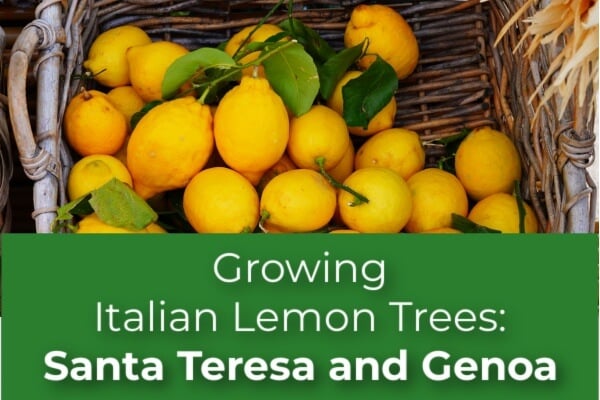Table of Contents
Growing an Italian Lemon Tree: Santa Teresa and Genoa
The Italian lemon tree varieties Santa Teresa and Genoa have rich histories and unique characteristics that make them popular with lemon lovers. They remind us of the romance and tranquility of the Italian coast. One of the most famous and prized lemon tree collection comes out of Medici villa in Florence.
Italian lemons are mainly revered for their amazing tart flavor and the high oil content of the rind. This makes the lemons ideal for making limoncello or infusing the lemon flavor in flavored sugars, teas and simple syrups. Italian lemons can be used like any classic lemon in cooking and baking and is delicious cooked in or consumed fresh.
Santa Teresa Lemon:
History: Santa Teresa lemons, also known as Limone di Sorrento or Sorrento lemons, originate from the picturesque region of Sorrento along the Amalfi Coast in southern Italy. This Italian lemon tree variety has been cultivated for centuries in this area known for its ideal climate and fertile soil, which contribute to the fruit's exceptional flavor and aroma.
Characteristics: Santa Teresa lemons are renowned for their vibrant yellow color, thin skin, and high juice content. They typically have fewer seeds compared to other lemon varieties, making them a favorite for culinary applications.
Uses: Due to their excellent flavor profile, Santa Teresa lemons are prized for both culinary and non-culinary purposes. They are commonly used in Italian cuisine to add a bright, tangy flavor to dishes such as seafood, salads, pasta, desserts, and beverages like limoncello. Beyond the kitchen, their fragrant zest is often used in perfumes, cosmetics, and aromatherapy products.
Santa Teresa Femminello Semi-Dwarf Lemon Tree

$65.00
--OVERVIEW-- Now Available in the 36"-48" Premium Size! The Santa Teresa lemon tree is a highly productive variety which grows medium sized lemons with a high acid content. Feminello selections account for nearly 75% of the Italian lemon crop each… read more
Genoa Lemon:
History: The Genoa lemon, also known as Limone di Genova, hails from the Liguria region of northwest Italy, where it has been cultivated for generations. Named after the historic port city of Genoa, this lemon variety has played a significant role in the culinary traditions of the region.
Characteristics: Genoa lemons are prized for their distinctively classic tart flavor, thin skin, and impressive juice content. They are slightly smaller in size compared to other lemon varieties like Eureka or Santa Teresa, but pack a delightful citrus punch.
Uses: Genoa lemons are valued for their versatile culinary uses, adding a unique sweetness to both savory and sweet dishes. They are commonly used in Italian cuisine to flavor seafood, salads, desserts, and beverages like lemonade and cocktails.
Genoa/ Genova Semi-Dwarf Lemon Tree

$65.00
--OVERVIEW-- Genoa Lemon trees are our most popular Italian Lemon tree. The Genoa Lemon was introduced into California from Genoa Italy in 1875, this variety has similar characteristics to the Eureka Lemon, though the Genoa is more compact, thornless… read more
Growing Santa Teresa and Genoa Lemon Trees:
1. Climate:
Italian lemon trees thrive in Mediterranean-like climates characterized by mild, wet winters and warm, dry summers. They prefer temperatures between 70-85°F (21-29°C) and are sensitive to frost. Santa Teresa and Genoa Lemon trees can be planted in the ground in USDA Zones 8-10, or in pots in USDA Zones 4-11. They are not frost tolerant and must be protected during periods of freezing temperatures. They grow very well in containers can can reach heights of 8-10 feet, or smaller with seasonal pruning. Lemon trees, like many other citrus trees, like to be slightly rootbound in containers, and can adapt very well to it's environment. Because of this, they are wonderful ornamentals as well as edible plants.
2. Sunlight:
Sun is crucial for lemon trees to thrive. Our grandfather used to say plant your citrus tree in the spot where the cat naps. A safe place to plant your Santa Teresa or Genoa lemon tree would be a location where it will receive full sunlight for at least 6-8 hours per day. South facing light is ideal for citrus trees. During extra hot or sunny days, some afternoon shade is ideal for all lemon trees. If your yard can not provide these conditions, consider planting your tree in a container so that it is moveable.
3. Soil:
Ensure a nutrient rich, well-draining, and chunky soil to promote healthy root development. Lemon trees in containers grow well in a mix of bark and potting soil. A popular combination is 5-1-1 mix, which is 5 parts bark (like cactus or orchid), 1 part citrus potting soil and 1 part perlite. we have a very similar mix available for our customers called the Primo Potting Mix. It is three bags, combined well together, make an excellent potting mix for citrus trees in containers. One order of Primo Potting Mix is enough to pot up 3 Primo sized citrus trees.
4. Watering:
Provide regular, deep watering to keep the soil consistently moist but not waterlogged. Allow the soil to dry out slightly between watering intervals. The frequency that you water will depend on the climate and how fast the water is absorbed by the root system. In pots, check to see if your tree needs water by inserting your finger into the soil. If the top 2" are dry, it is time to water.
5. Fertilization:
Feed your Italian lemon tree with a balanced fertilizer formulated for citrus trees, such as G&B Organics Fruit or Citrus Tree Fertilizer or Romeo Plant Food, following the manufacturer's instructions. Generally, organic fertilizer works best for in-ground trees and Romeo can be used for container or in-ground fruit trees.
6. Pruning:
Regular pruning helps maintain the tree's shape, encourages airflow, and promotes fruit production. Prune any dead or damaged branches and thin out overcrowded growth. To encourage branching at the tips, prune at the branch's node, which is the bud betweenthe stem and the leaf.
7. Protection:
Protect your lemon tree from pests such as aphids, scale insects, and citrus leaf miners by monitoring regularly and using organic pest control methods if necessary.
8. Harvesting:
Lemons are typically ready for harvest from late winter to early spring. Wait until the fruits reach their full color and size, then gently twist or cut them from the tree.
By providing optimal growing conditions and care, you can enjoy a bountiful harvest of flavorful lemons from your own Italian lemon tree. Experiment with different culinary creations like limencello or tart al limon to fully appreciate the unique characteristics of these Italian lemon varieties, and share the joy of homegrown citrus with family and friends.




